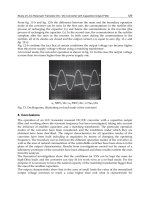Current Trends and Challenges in RFID Part 8 doc
Bạn đang xem bản rút gọn của tài liệu. Xem và tải ngay bản đầy đủ của tài liệu tại đây (2.96 MB, 30 trang )
Current Trends and Challenges in RFID
200
Results are quite relevant: despite the very good values obtained in case of alignment, in
general it emerges that no tag guarantees satisfactory performance levels in both cases and
for each orientation.
Fig. 11. A performance comparison on the items line by varying tag type and the tag-reader
antenna misalignment in presence of liquids and metals (ophthalmic solution).
Even more interesting are the results obtained by testing the tags in the cases line. As an
example, Fig. 13 and Fig. 14 reports the successful read rate evaluated by packing together
36 secondary packages of ophthalmic solution and 14 of bomb spray respectively, in the
three configuration previously described and named respectively Configuration I,
Configuration II, and Configuration III. It can be observed that the strong presence of metal
and liquid substantially inhibits the communication between reader and the NF tags.
Moreover, also when FF tags are considered, very low performance are obtained in each
configuration, demonstrating once more that general purpose commercial tags are not
appropriate for the implementation of complex item level tracing systems. It is substantially
due to the fact that such tags have been designed not taking into account the peculiarities of
the scenario where they must be utilized.
Fig. 12. A performance comparison on the items line by varying tag type and the tag-reader
antenna misalignment in presence of metals (Bomb spray).
High Performance UHF RFID Tags
for Item-Level Tracing Systems in Critical Supply Chains
201
Fig. 13. A performance comparison on the cases line by varying tag type and the
homogenous case composition in presence of liquids and metals (ophthalmic solution).
In the next section, a requirement analysis for a tag appositely designed to work in a
complex supply chain, such as the pharmaceutical one, are individuated and described and
are used to drive the development of a new high performance UHF RFID tag.
5. Requirements and guidelines in tags design
On the basis of the results shown in the previous sections, the realization of a tag designed
ad-hoc for the specific supply chain scenario is a must. Consequently, this section focuses on
the analysis of the pharmaceutical supply chain peculiarities and on the individuation of the
properties that a tag should own in order to guarantee high performance in all supply chain
steps, even when used to track items containing electromagnetically critical materials, such
as liquids and metals. It is worth observing, though, that the pharmaceutical sector is only
one of the many scenarios where a similar study could be of interest.
Fig. 14. A performance comparison on the cases line by varying tag type and the
homogenous case composition in presence of metals (Bomb spray).
One of the sources of performance degradation in the items line is given by the potential
misalignment between the NF reader antenna and the tag attached to the secondary package
Current Trends and Challenges in RFID
202
of an item. In fact, by means of a conveyor belt, the tagged item passes through two NF
RFID antennas.
Nevertheless, it is possible that the item surface on which the tag lies and the plane on
which the reader antennas lie are mutually orthogonal. Now, as depicted in Fig. 10, despite
the almost omnidirectional tag radiation pattern in free space condition, the presence of
metal or liquid inside the item strongly modifies the radiating properties, even inhibiting, in
some cases, the communication with the reader.
It can be deduced, hence, that a well performing tag should guarantee at least two main
lobes on the radiation pattern in every working condition, above all when it is used to trace
items containing hostile materials.
Another reason of reading-failure in the items line is due to the use of a FF tag antenna with
a NF reader antenna. Although NF reader antennas are used in the items line, NF UHF tags
cannot be used because they would not work properly in the subsequent supply chain steps,
where FF reader antennas are adopted. Therefore, a well performing tag should exhibit
good performance both in the NF and the FF.
On the items line step, the packages are read one by one and no multiple-readings related
problem arises; on the contrary, they will occur in the cases line and in the border gate. In
such cases, shielding effects due to the presence of plenty of items as well as the potential
overlapping of tags, could lead to a strong performance collapse. Furthermore, also in these
cases, problems due to a potential misalignment of tag and reader antennas can arise.
Consequently, a well performing tag should take into account such issues. Therefore, the tag
should be designed in order to avoid the complete tag overlapping and, moreover, it should
guarantee (also in this case) multiple radiation pattern lobes.
6. Design of new passive RFID UHF tags: the prototypal enhanced tag
The designed and realized Enhanced tag (patent pending number TO2010A000493) is
substantially based on a dual-lobe (collapsing in a particularly oriented one-lobe) conformal
label-type antenna, adaptable to the different shapes of the various item packages and easy to
be integrated in them. The shape of the antenna has been modeled in order to make the
complete tag overlapping highly improbable. Moreover, the common design solution, based
on the use of an inner loop around the microchip, has been adopted in order to guarantee
good performance also in NF condition. The antenna has been realized in copper tape. Cost
and size are comparable with canonical general-purpose UHF tags. Unfortunately, because of
the patent-pending status, no details can be given on the shape and on the electromagnetic
solutions adopted in order to reach the prefixed goal. Nevertheless, this is not even
fundamental because the primary purpose of this work is, on the contrary, to demonstrate that
an ad-hoc design of tags is able to effectively solve many of the performance degradation
problems affecting general-purpose UHF tags.
In Fig. 15 is reported the comparison, in terms simulated horizontal plane radiation pattern,
between the Enhanced tag (Fig. 15a) and the commercial Thin Propeller tag (Fig. 15b), when
the tags are attached to a cardboard-made secondary package containing a metallic cylinder.
It can be observed that the radiative behavior of the two devices is radically different.
In the Thin Propeller tag case, the radiation pattern is not omnidirectional anymore and the
link with the reader is possible only if the reader antenna is faced with the tag itself.
On the contrary, in the Enhanced tag case, an almost 45° oriented radiation pattern is found,
resulting from the combination of two mutually orthogonal lobes. This way, also reader
antennas orthogonal to the tag-plane can communicate with the tag.
High Performance UHF RFID Tags
for Item-Level Tracing Systems in Critical Supply Chains
203
a) b)
Fig. 15. Simulated horizontal radiation pattern of the a) Enhanced tag, and b) Thin Propeller
tag, when they are applied on a cardboard package containing a metal block.
7. Experimental results of the enhanced RFID UHF tag
In order to evaluate the effectiveness of the designed Enhanced tag in the pharmaceutical
supply chain, several experimental campaigns have been performed. In particular, a
performance comparison of the Enhanced tag with some of the above described commercial
UHF tags has been carried out in terms of successful read rate. In particular, taking into
account the performance analysis carried out on commercial FF and NF UHF tags, the
following four tag types with higher performance have been chosen in the comparison with
the Enhanced tag: Jumping Jack, Cube2, Dog Bone, and Thin Propeller. One for the NF
group and the others for the FF group.
Experimental campaigns have been mainly focused on particular operating conditions of
two steps of the pharmaceutical supply chain: the items line and the cases line. As
previously reported, these steps are particularly adequate to carry out an effective
validation of novel RFID tags.
In all tests, the speed of the conveyor belt has been set to 0.66 m/s and 0.33 m/s respectively
for the items line and cases line. The transmission power of the reader RFID has been set to
1W. Furthermore, the RFID tag is applied on the secondary package (made of cardboard) of
the medicine product. Two different types of products have been used: ophthalmic solution
in aluminum sachets and metallic bomb-spray.
The first part of the experimental campaign has been carried out on the items line. In this
test, the misalignment problem has been stressed. In particular, the three different operating
conditions (i.e. 0°, +90°, and -90°), previously described, have been considered.
The second part of the experimental campaign has been focused on the cases line. In such a
test, each case was composed off homogeneous items. In particular, the bomb-spray case
was prepared with 14 items on one layer, whereas the ophthalmic solution case was
prepared with 36 items on three layers.
All the results, reported in this paper, are characterized by a confidence level equal to 95%
with maximum relative error of 5%.
Current Trends and Challenges in RFID
204
Fig. 16 presents the performance comparison when a single item of ophthalmic solution,
enclosed in aluminum sachets, (i.e. liquid and metal) is scanned on the items line. The graph
clearly shows that the Enhanced tag is able to reach the optimal performance, i.e. a
successful read rate equal to 100%, in every critical operating conditions. More in detail, the
graph shows that although the performance of all tested tags are comparable under optimal
conditions (orientation equals to 0°), in critical conditions (orientation equal to -90° and
+90°) the performance of commercial tags decreases so abruptly to achieve in most cases a
percentage of successful read rate equal to 0%. Instead, the Enhanced tag reaches, also in
these conditions, 100% of successful readings. The results clearly show also that the NF UHF
tags are not able to solve performance problems in critical operating conditions (e.g.
presence of misalignment).
Fig. 16. A performance comparison between high-performance commercial tags and the
Enhanced tag on the items line by varying the tag-reader antenna misalignment in presence
of liquids and metals (ophthalmic solution).
In Fig. 17, the same performance comparison, using metallic bomb-spray, is shown. The
graph confirms the excellent performance achieved by the Enhanced tag in all operating
conditions on the items line. In this case, however, the performances obtained by some
commercial tags are comparable to those reached by the realized tag (100% of successful
read rate).
Fig. 17. A performance comparison between high-performance commercial tags and the
Enhanced tag by varying tag type and the tag-reader antenna misalignment in presence of
metals (Bomb spray).
High Performance UHF RFID Tags
for Item-Level Tracing Systems in Critical Supply Chains
205
Vice versa, the second part of the tests is aimed at comparing the tags performance in
another challenging step of the supply chain: the cases line. Fig. 18 shows the performance
comparison, in terms of successful read rate, of the Enhanced tag with the four commercial
tags (i.e. one for NF and three for FF) by varying the composition of the ophthalmic solution
case (i.e. Configuration I, Configuration II and Configuration III). It is worth noting that,
commercial tags have never reached successful read rate higher than 70%, while in all the
configurations the Enhanced tag has achieved the maximum performance. The results have
also demonstrated the very poor performance of the NF UHF tags when used in a cases line.
Finally, Fig. 19 shows the performance comparison when the case is composed of 14 items of
bomb-spray. In this case, only one commercial FF UHF tag (i.e. Jumping Jack) presents good
performance especially in Configurations I and III. On the contrary, other commercial tags
have shown very low performance. This permits to assert that, also in this case, the
Enhanced tag guarantees successful read rates better than the other tags.
Fig. 18. A performance comparison on the cases line between high-performance tags and the
Ehnanced tag by varying the homogenous case composition in presence of liquids and
metals (ophthalmic solution).
In order to further emphasize the Enhanced tag robustness also in even more critical
applications, an additional test has been performed. In particular, packages of milk have
been considered. They are characterized by an external package made in Tetra Pak, where
the percentage of metal is relevant, and by the presence of liquid. To test the effectiveness of
the Enhanced tag, a performance comparison with one of the most powerful commercial
tags (i.e. Dog Bone tag) has been carried out.
Also in this case, the measurement campaign has been carried out by considering both the
items line (configurations 0°, +90° and -90°) and the cases line (only the configuration I with
a 3 x 3 disposition of the single milk items).
Table 2 summarizes in detail the performance comparison between Enhanced tag end Dog
Bone tag in the items line and in the cases line steps considering the Tetra Pak milk package.
Also in this case the results are impressive: in the items line the Enhanced tag exhibits
always 100% of successful read rate regardless of the package orientation. The commercial
Dog Bone tag, instead, shows good results only in the optimal condition. In all other cases it
cannot be read.
Even in the cases line the Enhanced tag is much more robust than Dog Bone. In fact, as can
be observed in the same Table 2, the Dog Bone is never read, whereas the Enhanced tag
Current Trends and Challenges in RFID
206
achieves a successful read rate higher than 60%. This clearly demonstrates the qualities in
terms of robustness and reliability of the proposed Enhanced tag even in contexts different
from those the tag has been designed for.
Fig. 19. A performance comparison on the cases line between high-performance commercial
tags and the Enhanced tag by varying the homogenous case composition in presence of
metals (Bomb spray).
Items line Cases line
0° +90° -90° Conf. I
Enhanced tag
100% 100% 100% 61%
Dog Bone tag
93% 0% 0% 0%
Table 2. Performance comparison between Enhanced tag and Dog Bone tag applied on Tetra
Pak package.
8. Conclusion
In this chapter, the problem of the effective RFID-based traceability performed at item
level has been addressed. The pharmaceutical supply chain has been considered and its
criticalities, in terms of kinds of goods to trace and peculiarities of the checkpoints RFID,
have been individuated and discussed. The inadequateness of the use of commercial
general purpose tags has been proved through an exhaustive performance evaluation
campaign, aimed at evaluating the successful read rate in each step of the supply chain for
numerous tagged products. Six different commercial Far Field UHF tags and two Near
Field UHF tags have been tested; these last are the less reliable, but also the Far Field ones
exhibit strong limits when used to trace products containing metals or liquids.
Consequently, by taking into account the traceability scenario, the requirements that a tag
should own in order to overcome such limits have been individuated and, on such basis, a
new enhanced tag has been realized. Its performance has been rigorously evaluated and
the obtained impressive results demonstrate that, if the tag is designed considering the
peculiarities of the specific tracing system, a successful read rate of 100% can be obtained,
regardless of the supply chain step, the composition of the traced product, and the
operating conditions. Finally, a very severe test has been carried out, aimed at evaluating
High Performance UHF RFID Tags
for Item-Level Tracing Systems in Critical Supply Chains
207
the performance of our Enhanced tag on Tetra Pak packets containing milk. This
application is one of the most challenging because of the very massive presence of both
metal and liquids without any air in the middle. Very surprisingly, the performance are
quite good also in this case, undoubtedly demonstrating once more that when a tag is
designed by taking into account the peculiarities of the tracing systems, high performance
can be obtained even in particularly critical conditions.
9. Acknowledgment
The authors wish to thank Dr. Vincenzo Mighali and Dr. Maria Laura Stefanizzi, that
collaborate with the IDA Lab of the Department of Innovation Engineering of the University
of Salento (Lecce, Italy), without whose assistance this study would not have been
successful.
10. References
Acierno, R.; De Riccardis, L.; Maffia, M.; Mainetti, L.; Patrono, L.; Urso, E (2010). Exposure to
Electromagnetic Fields in UHF Band of an Insulin Preparation: Biological Effects,
Proceeding of IEEE Biomedical Circuits and Systems Conference, Paphos, Cipro,
November 2010
Aroor, S.R.; Deavours, D.D. (2007). Evaluation of the State of Passive UHF RFID: An
Experimental Approach. IEEE Systems Journal, vol.1, no.2, (December 2007),
pp.168-176, ISSN : 1932-8184
Barchetti, U.; Bucciero, A.; De Blasi, M.; Mainetti, L.; Patrono, L. (2010). RFID, EPC and B2B
convergence towards an item-level traceability in the pharmaceutical supply chain,
Proceeding of IEEE International Conference on RFID-Technology and
Applications, Guangzhou, China, June 2010
Bertocco, M.; Dalla Chiara, A.D.; Sona, A. (2010). Performance evaluation and optimization
of UHF RFID systems, Proceeding of Instrumentation and Measurement
Technology Conference, (3-6 May 2010), pp.1175-1180, ISSN: 1091-5281
Bertocco, M.; Dalla Chiara, A.; Gamba, G.; Sona, A. (2009). Experimental analysis of UHF
RFID impairments and performance, Proceeding of IEEE International
Instrumentation and Measurement Technology Conference, ISBN: 978-1-4244-3353-
7, Singapore, May 2009
Catarinucci, L.; Colella, R.; De Blasi, M.; Patrono, L.; Tarricone, L. (2010). Improving Item-
Level Tracing Systems through Ad Hoc UHF RFID Tags, Proceeding of IEEE Radio
and Wireless Symposium, New Orleans, LA (USA), January 2010
De Blasi, M.; Mighali, V.; Patrono, L. & Stefanizzi, M. L. (2010). Performance Evaluation of
UHF RFID tags in the Pharmaceutical Supply Chain, Paper presented at The
Internet of Things - 20th Tyrrhenian International Workshop on Digital
Communications, Pula, Sardinia, Italy, September 2009.
Finkenzeller, K. (2003). RFID Handbook, Fundamentals and Applications in Contact-less
Smart Cards and Identification, Wiley & Sons, ISBN 978-0-470-84402-1
Fuschini F.; Piersanti, C.; Sydanheimo, L.; Ukkonen, L.; Falciasecca, G. (2010).
Electromagnetic Analyses of Near Field UHF RFID Systems, IEEE Transaction on
Antennas and Propagation, Vol. 58, No. 5, (May 2010) pp. 1759-1770
Current Trends and Challenges in RFID
208
Mirowski L. et al. (2009). An RFID Attacker Behavior Taxonomy. IEEE Pervasive Computing
Magazine, (October-December 2009), pp.79-84, ISSN: 1536-1268
Nikitin, P. V. and Rao, K.V.S. (2006). Performance Limitations of Passive UHF RFID
Systems, Proceeding of IEEE Antennas and Propagation Society International
Symposium, Albuquerque, NM, July 2006
Rao, K.V.S.; Nikitin, P.V.; Lam, S.F. (2005). Antenna design for UHF RFID tags: a review and
a practical application. IEEE Transactions on Antennas and Propagation, vol.53,
no.12, pp. 3870- 3876, (December 2005), ISSN: 0018-926X
Ramakrishnan, K. M. and Deavours, D.D. (2006). Performance Benchmarks for Passive UHF
RFID Tags, Proceeding of 13th GI/ITG Conference on Measurement, Modeling,
and Evaluation of Computer and Communication Systems, Nurenberg, Germany,
March 2006
Staake, T.; Thiesse, F.; Fleisch, E. (2005). Extending the EPC network: the potential of RFID in
anti-counterfeiting, Proceeding of ACM symposium on Applied computing, ACM
Press New York, NY, USA, 2005
Koo, T.W.; Kim, D.; Ryu, J.I.; Kim, J.K.; Yook, J.G.; Kim, J.C. (2010). Design and
Implementation of Label-type UHF RFID Tags for the Metallic Object Application,
Proceeding of IEEE Antennas and Propagation Society International Symposium,
Toronto, Canada, July 2010
Thiesse, F.; Floerkemeier, C.; Harrison, M.; Michahelles, F.; Roduner, C. Technology,
Standards, and Real-World Deployments of the EPC Network. IEEE Internet
Computing, vol.13, no.2, pp.36-43, (March-April 2009), ISSN: 1089-7801
Uysal, D. D.; Emond, J. P.; Engels, D. W. (2008). Evaluation of RFID performance for a
pharmaceutical distribution chain: HF vs. UHF, Proceedings of IEEE international
conference on RFID, Las Vegas, Nevada, USA, April 2008.
Part 3
Readers
11
Design and Implementation of Reader
Baseband Receiver Structure in a
Passive RFID Environment
Ji-Hoon Bae
1
, Kyung-Tae Kim
2
, WonKyu Choi
1
and Chan-Won Park
1
1
Electronics and Telecommunication Research Institute
2
Pohang University of Science and Technology (POSTECH)
Republic of Korea
1. Introduction
In this chapter, we present a demodulation structure suitable for a reader baseband receiver
in a passive Radio Frequency IDentification (RFID) environment. RFID refers to a
technology which uses radio communications to contactlessly identify a tagged physical
object [1-2]. An RFID system may include a plurality of electronic tags on objects, animals,
and other things having unique identification information and a reader for reading or
writing information from or to the tags. RFID systems can be variously classified into the
inductively coupled and electromagnetic schemes according to the communication method
employed between an RFID reader and a tag, into an active type and a passive type
according to whether the tag operates using its own power or not, and into long wave,
medium wave, shortwave, ultrashort wave, and microwave depending on the frequency of
the electric waves used for the communication [1-2]. Essentially, a passive RFID system
consists of a reader and a passive tag without a battery. The International standard, ISO
18000-6C, defines the communication protocol and Ultra High Frequency (UHF) band
between the reader and the passive tag [3]. Many studies have been conducted in the field of
UHF RFID, as described in [4-14]. In the case of passive UHF RFID technology, the reader
must provide the tag with continuous radio power, while the tag sends its information to
the reader via a backscatter modulation. The tag encodes the backscattered signal as either
FM0 (bi-phase space) or Miller modulation of subcarrier at the given data rate [3]. Recently,
UHF Passive RFID has a trend of extending its domain to the application of an item-level-
tagging (ILT) from that of a conventional pallet/case-level-tagging. In the ILT RFID
environment, tags can be attached on the objects composed partially of a metal or liquid and
can be placed at a nearby complicated surrounding in which the metallic objects exist. As a
result, if undesired large signal reflected from the complicated surrounding is received at
the reader receiver during receiving a desired backscattered tag signal, the performance of
the identification for the reader can be easily degraded due to the reflected large signal
which can leak to the reader receiver (Fig. 1(a)). In addition, if insufficient isolation is
guaranteed between the transmitter and receiver, the transmission power (Tx power)
created by the reader transmitter can leak to the receiver (Fig. 1(a)) [2]. A reflected power
larger than the backscattered tag signal which is generated by the return loss (S11) of the
Current Trends and Challenges in RFID
212
antenna can also leak to the receiver via the circulator (Fig. 1(a)). Because of these unwanted
leakage components in the reader receiver, the DC-offset phenomenon can occur in the
baseband of the reader receiver.
Fig. 1. Description of leakage components (a) and the corresponding DC-offset phenomenon
(b) in a passive RFID communication environment
As a result, the received baseband signal can be corrupted by the DC-offset phenomenon
(Fig 1(b)). For example, Fig. 1(b) shows the Miller subcarrier signal highly affected by the
DC offset phenomenon in our reader receiver measured using an Agilent Logic Analyzer.
Due to the unwanted DC-offset phenomenon, the reader baseband receiver may not
determine the valid bit data with sufficient reliability. There have been several researches to
reduce the originally generated leakage components in advance, as reported in [4-6].
However, it may be difficult to perfectly and adaptively eliminate the leakage components
in the ILT RFID field, in which the performance of the reader receiver can be adversely
affected by the unwanted large reflected signals. Therefore, although the received baseband
signal is contaminated with the DC-offset phenomenon, we attempt to further remove the
DC-offset phenomenon from the distorted received signal in the baseband receiver. In the
earlier study, we proposed a demodulation structure composed of an edge signal generator,
an edge extractor and a signal reconstruction block for the FM0 signal distorted by the DC-
offset phenomenon [14]. In this chapter, a similar concept is also applied to the reliable
reconstruction of the Miller subcarrier signal not suffering from the DC-offset phenomenon
by using the phase inversion information instead of the amplitude information. In order to
Design and Implementation
of Reader Baseband Receiver Structure in a Passive RFID Environment
213
accomplish this, we detect the valid information from the corrupted signals by making use
of a demodulation structure composed of a peak signal generator, a peak detector, and a
signal reconstruction block, in order to successfully decode the received baseband signal
distorted by the DC-offset phenomenon. According to the proposed demodulation method,
the peak signal is created at the position of phase inversion within the Miller subcarrier
signal sequence using the phase inversion information. Therefore, although a certain
amount of DC-offset noise can be appeared in the baseband of the reader receiver, the
proposed method is allowed to supplementally deal with the DC-offset phenomenon once
more in the baseband receiver.
This chapter is organized as follows. In Section 2, we describe in detail the demodulation
structure and method used to extract meaningful information from the distorted Miller
subcarrier signal suffering from the DC-offset phenomenon. In Section 3, we show the
simulation and implementation results. Finally, we draw our conclusions in Section 4.
2. Demodulation algorithm
In this section, we introduce the demodulation structure and algorithm suitable for the
reconstruction of the Miller subcarrier signal distorted by DC-offset noise.
2.1 Demodulation of the Miller subcarrier-encoded signal
The Miller modulated sequence contains exactly two, four, or eight subcarrier cycles per bit,
depending on the M value (M = 2,4,8) specified in [3]. Namely, if M has a value of 2, the
Miller basis signal is multiplied by a square-wave at 2 times the symbol rate (1/
()
b
M
T ),
resulting in a Miller subcarrier signal with M = 2, as shown in Fig. 2. For the reliable
reconstruction of the Miller subcarrier signal under the DC-offset environmnet, Fig. 3 shows
the proposed demodulation architecture, which includes a peak signal generator, a peak
extractor, and a signal reconstruction block, similar to the FM0 demodulation structure [14].
As shown in Fig. 3, the received signal, r(t) is composed of an in-phase channel (I-channel)
signal,
()
I
rt, and a quadrature-phase channel (Q-channel) signal, ( )
Q
rt including DC-offset
noise,
dc
n , and the complex additive noise, ()nt , which is a sample function of a white
Gaussian process with power spectrum
0
/2N watts/hertz. At this point, the DC-offset
noise (
dc
n ) can be expressed as follows [14]:
()
()
d
jt
Bt
dc dc
w
nt A ee (1)
where
dc
A is the initial DC-offset value,
Bt
e
and
d
j
wt
e represent the damping term and
oscillation term of the DC-offset noise, respectively, and
j
e
is the initial phase of the DC-
offset noise. By adjusting the parametrs
dc
A , B, and
d
w related to the DC-offset noise to
proper values, any kind of DC-offset phenomenon in the area of passive RFID can be
established.
In order to generate the peak signal with respect to the received baseband signal
r(t) which
is sampled at a sampling rate of
1/
s
T , the initial peak signal
1
()
p
rt is designed using the
predefined
0
()
m
stand
1
()
m
st as follows:
110
, ( ), 0,1,2,
() { () ()}
s
p
tkTk
rt LPFrt rt
(2)
Current Trends and Challenges in RFID
214
where
0
()rtis the output signal using
0
()
m
stvia the I and Q channels and is defined as
follows:
000
1
() () () () ()
Im Qm
I channel
Q channel
rt rt st rt st
A
, (3)
where,
A is the normalized gain, and )(
1
tr is the output signal using )(
1
ts
m
via the I and Q
channels and is defined as follows:
111
1
() () () () ()
Im Qm
I channel
Q channel
rt rt st rt st
A
(4)
0
()
m
st has the same form as data-0 of the Miller subcarrier and
1
()
m
st has the same form as
data-1 of the Miller subcarrier [3]. If
M is four, then
0
()
m
st and
1
()
m
st can be described by
Fig. 4. In our method, the low pass filtering of the difference signal between
1
()rt and )(
0
tr
is required for the generation of the desired peak signal.
Fig. 2. Configuration of the Miller subcarrier signal with
M = 2
In the second step, the created initial peak signal )(
1
tr
p
is reconstructed by removing the
low level noise included in the specific level of the initial peak signal. This operation is
implemented in the level decision block by using a reference level
ref
r (Fig. 3). The reference
level for the level decision is fixed at a value of 0. This is because the two orthogonal basis
functions
)(
0
ts
m
and )(
1
ts
m
participate in building the peak signal through Eq. (2), while
only one basis function is used for the generation of the edge signal for the case of the FM0
signal [14]. Therefore, the demodulation method of the Miller subcarrier signal has the
advantage that there is no need to find the optimal decision level, unlike the adaptive level
decision method in the case of the FM0 signal. Then, the final peak signal can be obtained
after the level decision by using the fixed reference level and the initial peak signal as
follows:
11
2
1
(), ( 0)
()
0, (0)
p p ref
p
p ref
rt r r
rt
rr
(5)
Design and Implementation
of Reader Baseband Receiver Structure in a Passive RFID Environment
215
In the next step, from the final peak signal,
2
()
p
rt
, the peak extractor (Fig. 3) finds the
positions of the peaks using a peak detection algorithm which is identical to that of the edge
extractor in Fig. 5 [14]. Finally, in the signal reconstruction block (Fig. 3), the basedband
signal without DC-offset noise is regenerated by a state diagram which is also identical to
that of the signal reconstruction block in Fig. 6 [14]. Therefore, the procedure for the
proposed Miller subcarrier demodulation algorithm can be summarized as shown in Fig. 5
Fig. 3. Proposed demodulation structure for the purpose of reconstructing the Miller
subcarrier signal distorted by DC-offset noise
Fig. 4. Description of the two orthogonal basis functions,
0
()
m
st
and
1
()
m
st
2.2 Determination of the low pass filter specification
In our method for the demodulation of the Miller subcarrier signal, the difference signal
between
)(
1
tr
and
)(
0
tr
must be reformed using a low pass filter (LPF), as mentioned in
Current Trends and Challenges in RFID
216
Fig. 5. Flowchart illustrating the Miller subcarrier demodulation method
Section 2.1. Fig. 6(a) shows the spectral response of the difference signal of the Miller
subcarrier signal with M = 4 before the LPF, and Fig. 6(b) represents the spectral response of
the initial peak signal
1
()
p
rt after the LPF. To obtain the peak signal from the difference
signal before the LPF, the second harmonic component of the difference signal (Fig. 6(a))
must be attenuated below a certain level, as shown in Fig. 6(b). We observe in Fig. 7 that, as
the attenuation level
dB
A
tt
is increased, the error rate performance (
e
p
) for the Miller
subcarrier signal is improved. However, the computational complexity for the design of the
filter is also increased. This is because the order of the designed filter is increased to obtain
the high level of the
dB
A
tt
. Meanwhile, when the
dB
A
tt
increase to a value larger than about
70dB, there is no noticeable improvement of the error rate performance. From the result
shown in Fig. 7, we found that a level of attenuation
dB
A
tt
ranged from 70dB to 80dB can
provide a suitable tradeoff between the computational complexity and the error rate
Design and Implementation
of Reader Baseband Receiver Structure in a Passive RFID Environment
217
performance for the demodulation algorithm. The result in Fig. 6(b) was obtained using a
39th order LPF with an attenuation level of 70dB and the magnitude response of the
designed LPF is shown in Fig. 8
Fig. 6. Spectral responses of the difference signal before LPF (a) and the initial peak signal
after LPF (b) (320kHz-Miller subcarrier signal with M = 4)
3. Simulation & experimental results
For the first example, we consider the operation of the proposed demodulation structure
when the received baseband signal is the distorted Miller subcarrier-encoded signal with
DC-offset noise (
dc
A = 5, B =
s
T / 100
b
T
, and
d
w = 1/(
b
T
100)). Fig. 9 shows the
demodulation result of the Miller subcarrier signal with M = 2. Case 1 of Fig. 9(a) and Case 2
of Fig. 9(b) represent the output signals
0
()rt in Eq. (3) and
1
()rt in Eq. (4), respectively.
From the results, we observe that both output signals,
0
()rt and
1
()rt, are robust to the
variation of the amplitude, although the I- and Q-channel received baseband signals are
severely distorted by DC-offset noise. Fig. 9(c) represents the difference signal between
1
()rt
and
0
()rt and the corresponding initial peak signal after the LPF. A 54th order LPF is
designed for the generation of the initial peak signal
1
()
p
rt
, in order to attenuate the
amplitude response of the filter to about 80dB. The spectral responses of the difference
signal before the LPF and the initial peak signal after the LPF, and the magnitude response
of the designed 54th order LPF are shown in Fig. 10. Fig. 9(d) represents the final peak
signal
2
()
p
rt
using the fixed reference level of 0 and the initial peak signal
1
()
p
rt
. Note that
the generated peaks of
)(
2
tr
p
are placed at every position at which a phase inversion occurs
within the Miller subcarrier signal sequence. Finally, as shown in Fig. 9(e), the reconstructed
baseband signal without the DC-offset noise is obtained using the peak extraction algorithm
of the peak extractor and the state diagram of the signal reconstruction block. The resulting
signal in Fig. 9(e) has the same form as the Miller basis signal, which is obtained by
removing the rectangular subcarrier signal from the Miller subcarrier signal, as shown in
Fig. 2. This is because the peak signal
2
()
p
rt
, which appears at a position having phase
inversion, is used to reconstruct the Miller baseband signal.
Current Trends and Challenges in RFID
218
Fig. 7. The error rate performances for several values of
dB
A
tt
Fig. 8. The magnitude response of the designed 39th order low-pass filter for the generation
of the initial peak signal
Design and Implementation
of Reader Baseband Receiver Structure in a Passive RFID Environment
219
Fig. 9. Operation results of the proposed demodulation structure shown in Figure 3
(320kHz-Miller subcarrier signal with M = 2)
Current Trends and Challenges in RFID
220
Fig. 10. Spectral responses of the difference signal before LPF (a) and the initial peak signal
after LPF (b), and the magnitude response of the designed 54th order LPF (c) (320kHz-Miller
subcarrier signal with M = 2)
For the second example, the Miller subcarrier signal with M = 4 is considered for the signal
reconstruction, as shown in Fig. 11. The descriptions of Fig. 11 are explained as follows:
Case 1: the output signal
0
()rt
in Eq. (3) using
)(
0
ts
m
Case 2: the output signal
1
()xt
in Eq. (4) using
)(
1
ts
m
Case 3: the difference signal between
1
()rt
and
0
()rt
before the 39th order LPF having an
attenuation level of 70dB
Case 4: initial peak signal
1
()
p
rtafter the 39th order LPF
Case 5: final peak signal
2
()
p
rtusing the fixed reference level and the initial peak signal
1
()
p
rt
Case 6: Reconstructed Miller baseband signal without DC-offset noise
Design and Implementation
of Reader Baseband Receiver Structure in a Passive RFID Environment
221
Fig. 11. Operation results of the proposed demodulation structure shown in Figure 3
(320kHz-Miller subcarrier signal with M = 4)
Current Trends and Challenges in RFID
222
In the next example, we implemented the proposed demodulation structure as a hardware
device FPGA (Field Programmable Gate Array) and then the operation of the demodulation
structure is observed using the commercial DSP design tool, Xilinx System Generator which
provides hardware co-simulation, making it possible to incorporate the demodulation
design running in an FPGA directly into a MATLAB Simulink simulation [15]. Fig. 12 shows
the designed hardware co-simulation model of the proposed demodulation structure using
a Black Box and JTAG Co-Sim library block provided by the System Generator. The Black
Box library block allows a designed HDL (hardware description language), such as VHDL
and Verilog, to be brought into the Simulink design model and enables us to easily observe
the corresponding simulation behaviour in MATLAB Simulink.
In order to execute the designed Simulink model of the demodulation structure in Fig. 12, the
following hardware co-simulation environment should be considered as shown in Table 1.
Fig. 12. Hardware co-simulation model with Black Box and JTAG Co-Sim library block
Design and Implementation
of Reader Baseband Receiver Structure in a Passive RFID Environment
223
Items Descriptions
MATLAB MATALB 2008a
System Generator Xilinx System Generator 10.1
HDL design tool Xilinx ISE 10.1
HDL simulation tool ModelSim SE 6.2b
FPGA (Digital hardware board) Xilinx SPARTAN-3 XC3S4000FGG676-5G
JTAG Cable Xilinx USB cable
Simulink system period [sec] 3.90625e-7 (1/2.56MHz)
Table 1. Hardware co-simulation configuration for the verification of the demodulation
structure
Meanwhile, the Black Box HDL can be co-simulated with MATLAB Simulink using the
System Generator interface to either ISE simulator or the ModelSim simulation software
from Model Technology, Inc. Fig. 13 shows the operation result of the demodulation
structure using the latter method through ModelSim when the measured Miller subcarrier
signal (Fig. 2(b)) is considered. The operation result (Scope 2) using the former method
through ISE simulator is also shown in Fig. 14
Fig. 13. Simulation result showing Black Box output through ModelSim for the proposed
demodulation structure









